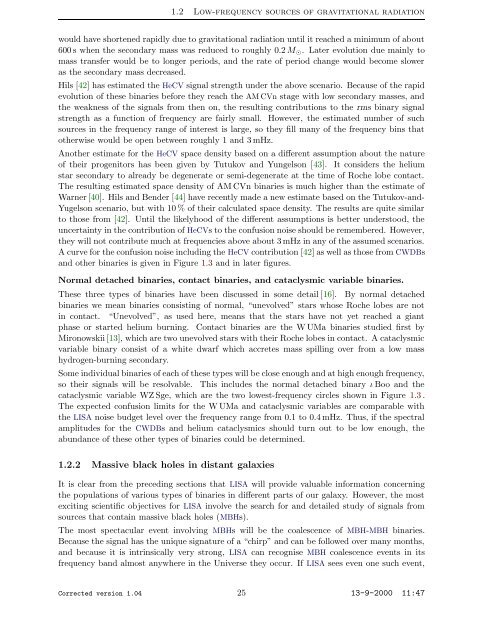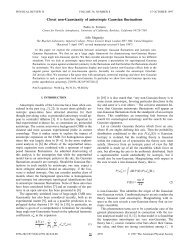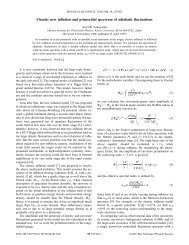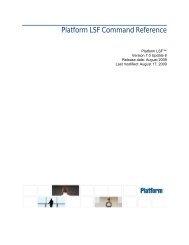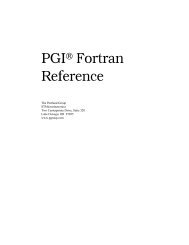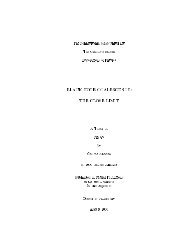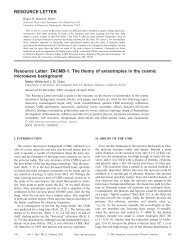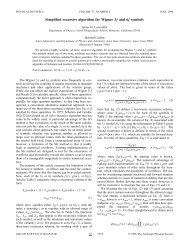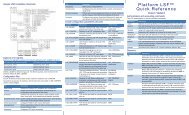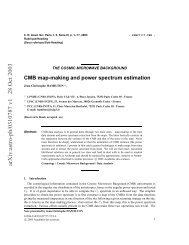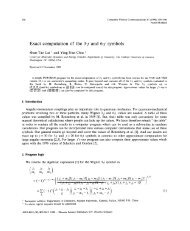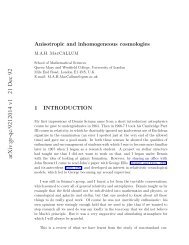LISALISA - iucaa
LISALISA - iucaa
LISALISA - iucaa
Create successful ePaper yourself
Turn your PDF publications into a flip-book with our unique Google optimized e-Paper software.
1.2 Low-frequency sources of gravitational radiation<br />
would have shortened rapidly due to gravitational radiation until it reached a minimum of about<br />
600 s when the secondary mass was reduced to roughly 0.2M ⊙ . Later evolution due mainly to<br />
mass transfer would be to longer periods, and the rate of period change would become slower<br />
as the secondary mass decreased.<br />
Hils [42] has estimated the HeCV signal strength under the above scenario. Because of the rapid<br />
evolution of these binaries before they reach the AM CVn stage with low secondary masses, and<br />
the weakness of the signals from then on, the resulting contributions to the rms binary signal<br />
strength as a function of frequency are fairly small. However, the estimated number of such<br />
sources in the frequency range of interest is large, so they fill many of the frequency bins that<br />
otherwise would be open between roughly 1 and 3 mHz.<br />
Another estimate for the HeCV space density based on a different assumption about the nature<br />
of their progenitors has been given by Tutukov and Yungelson [43]. It considers the helium<br />
star secondary to already be degenerate or semi-degenerate at the time of Roche lobe contact.<br />
The resulting estimated space density of AM CVn binaries is much higher than the estimate of<br />
Warner [40]. Hils and Bender [44] have recently made a new estimate based on the Tutukov-and-<br />
Yugelson scenario, but with 10 % of their calculated space density. The results are quite similar<br />
to those from [42]. Until the likelyhood of the different assumptions is better understood, the<br />
uncertainty in the contribution of HeCVs to the confusion noise should be remembered. However,<br />
they will not contribute much at frequencies above about 3mHz in any of the assumed scenarios.<br />
A curve for the confusion noise including the HeCV contribution [42] as well as those from CWDBs<br />
and other binaries is given in Figure 1.3 and in later figures.<br />
Normal detached binaries, contact binaries, and cataclysmic variable binaries.<br />
These three types of binaries have been discussed in some detail [16]. By normal detached<br />
binaries we mean binaries consisting of normal, “unevolved” stars whose Roche lobes are not<br />
in contact. “Unevolved”, as used here, means that the stars have not yet reached a giant<br />
phase or started helium burning. Contact binaries are the WUMa binaries studied first by<br />
Mironowskii [13], which are two unevolved stars with their Roche lobes in contact. A cataclysmic<br />
variable binary consist of a white dwarf which accretes mass spilling over from a low mass<br />
hydrogen-burning secondary.<br />
Some individual binaries of each of these types will be close enough and at high enough frequency,<br />
so their signals will be resolvable. This includes the normal detached binary ι Boo and the<br />
cataclysmic variable WZSge, which are the two lowest-frequency circles shown in Figure 1.3 .<br />
The expected confusion limits for the W UMa and cataclysmic variables are comparable with<br />
the LISA noise budget level over the frequency range from 0.1 to 0.4 mHz. Thus, if the spectral<br />
amplitudes for the CWDBs and helium cataclysmics should turn out to be low enough, the<br />
abundance of these other types of binaries could be determined.<br />
1.2.2 Massive black holes in distant galaxies<br />
It is clear from the preceding sections that LISA will provide valuable information concerning<br />
the populations of various types of binaries in different parts of our galaxy. However, the most<br />
exciting scientific objectives for LISA involve the search for and detailed study of signals from<br />
sources that contain massive black holes (MBHs).<br />
The most spectacular event involving MBHs will be the coalescence of MBH-MBH binaries.<br />
Because the signal has the unique signature of a “chirp” and can be followed over many months,<br />
and because it is intrinsically very strong, LISA can recognise MBH coalescence events in its<br />
frequency band almost anywhere in the Universe they occur. If LISA sees even one such event,<br />
Corrected version 1.04 25 13-9-2000 11:47


